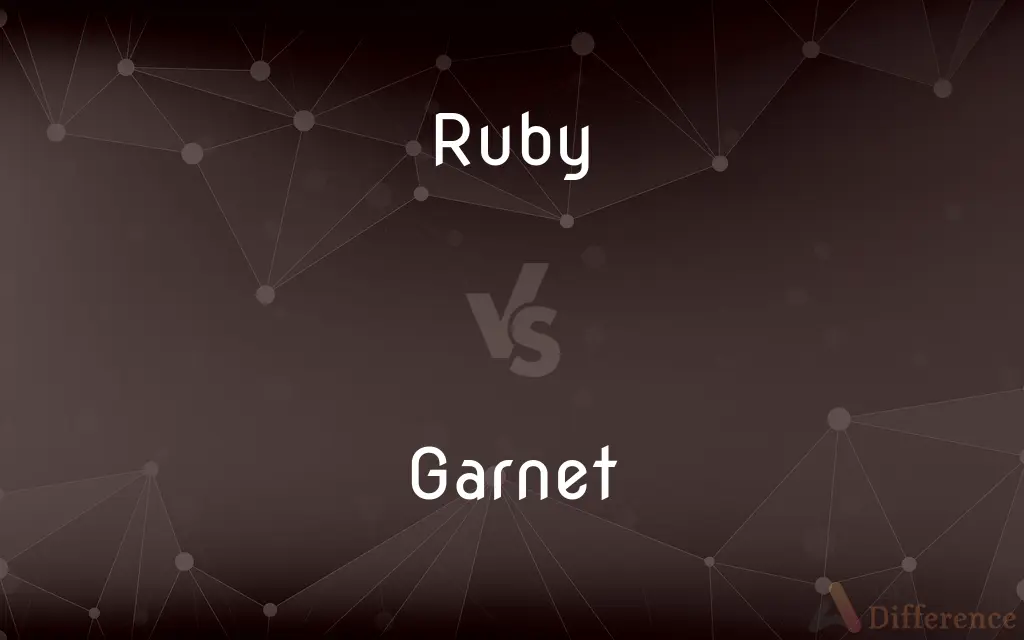Ruby vs. Garnet — What's the Difference?
By Fiza Rafique & Maham Liaqat — Updated on March 16, 2024
Ruby is a precious gemstone known for its vibrant red color and durability, derived from corundum, while garnet is a group of silicate minerals known for a wide range of colors, including deep red.

Difference Between Ruby and Garnet
Table of Contents
ADVERTISEMENT
Key Differences
Ruby and garnet are both popular gemstones that exhibit a rich red hue, but they come from different mineral families and possess distinct characteristics. Ruby is a variety of corundum and is prized for its hardness, brilliance, and deep red color, often caused by chromium impurities. Garnet, on the other hand, refers to a group of silicate minerals that share a similar crystal structure but can vary greatly in composition and color, including red, green, yellow, and even blue.
The value of rubies is generally higher than that of garnets due to the former's rarity, exceptional hardness (second only to diamonds), and the vibrant red color that is highly sought after in the jewelry market. Rubies are often treated with heat to enhance their color and clarity, a common practice that affects their market value. Garnets, while also beautiful, are more abundant and offer a wider range of colors, but the red varieties are sometimes mistaken for rubies by those not familiar with their subtle differences.
One of the key differences between ruby and garnet is their chemical composition and hardness. Ruby, being a form of corundum, has a Mohs hardness of 9, making it extremely durable and suitable for all types of jewelry, including rings that are worn daily. Garnets have a hardness ranging from 6.5 to 7.5, depending on the variety, making them durable but not as resistant to scratching and wear as rubies.
Rubies exhibit a phenomenon known as fluorescence, which can make them appear to glow from within under certain lighting conditions, enhancing their color and appeal. This effect is due to the presence of chromium. Garnets, lacking chromium, do not typically show fluorescence, which can help distinguish between the two when observed under ultraviolet light.
Both rubies and garnets have been cherished throughout history for their beauty and supposed protective powers. While rubies have often been associated with wealth, power, and love, garnets have been worn as talismans for protection and health. Their enduring popularity underscores their appeal across different cultures and periods.
ADVERTISEMENT
Comparison Chart
Composition
Aluminum oxide with chromium.
Silicate minerals with varying compositions.
Color
Primarily deep red.
Wide range, including red, green, yellow, and blue.
Hardness (Mohs)
9
6.5 to 7.5
Rarity
More rare, especially high-quality specimens.
Common, with wide availability and variety.
Value
Generally higher due to rarity and demand.
Lower than rubies, varies with type and quality.
Fluorescence
Often exhibits strong fluorescence.
Typically does not exhibit fluorescence.
Compare with Definitions
Ruby
A precious gemstone of the corundum family, distinguished by its deep red color and excellent hardness, often associated with love and passion.
The ruby ring she wore sparkled intensely, its deep red hue symbolizing deep affection.
Garnet
A group of silicate minerals known for their wide range of colors, from deep red to vibrant green, used both as abrasives and gemstones.
The garnet necklace she wore complemented her dress perfectly, its red stones gleaming under the light.
Ruby
A mineral known for its hardness, second only to diamonds, and valued in jewelry for its striking red appearance and luster.
He chose a ruby for the engagement ring, signifying eternal love with its enduring hardness and fiery color.
Garnet
A mineral known for its durability and vibrant colors, widely sought after for jewelry making and industrial applications due to its hardness.
The artisan used garnet in his designs, attracted by its variety of colors and the gemstone's natural beauty.
Ruby
A symbol of wealth and prosperity, this gemstone is celebrated for its deep red color, often enhanced through heat treatment to improve clarity.
The museum's exhibit featured a historic ruby that had once belonged to royalty, showcasing its magnificent color and cut.
Garnet
A gemstone that ranges in color from deep red to bright green, often mistaken for ruby but distinguishable by its chemical composition and brilliance.
The vintage brooch featured a large garnet, its deep red color almost as captivating as that of a ruby.
Ruby
A corundum variety, cherished throughout history for its rarity and the vibrancy of its red, often associated with courage and strength.
The ancient warriors were awarded rubies for bravery, the stone's bold red color echoing their valor.
Garnet
A versatile gemstone available in various colors, including the popular deep red, known for its affordability and use in jewelry.
For their anniversary, he gifted her a garnet bracelet, its rich red hue symbolizing enduring affection.
Ruby
A vibrant red gem that ranks among the most sought-after for its beauty, durability, and rarity, made primarily of aluminum oxide.
The crown jewel of the collection was a large ruby, its brilliance unmatched by any other stone.
Garnet
A family of minerals highly valued in both the gemstone market and industrial uses, known for their wide color spectrum and relative abundance.
The geologist explained the properties of garnets, emphasizing their importance beyond jewelry to fields like industrial abrasive manufacturing.
Ruby
A ruby is a pink to blood-red colored gemstone, a variety of the mineral corundum (aluminium oxide). Other varieties of gem-quality corundum are called sapphires.
Garnet
Garnets ( ) are a group of silicate minerals that have been used since the Bronze Age as gemstones and abrasives. All species of garnets possess similar physical properties and crystal forms, but differ in chemical composition.
Ruby
A precious stone consisting of corundum in colour varieties varying from deep crimson or purple to pale rose
A ruby eternity ring
A necklace of rubies
Garnet
Any of several common, widespread aluminum or calcium silicate minerals occurring in two internally isomorphic series, (Mg, Mn, Fe)3Al2Si3O12 and Ca3(Cr, Al, Fe)2Si3O12, generally crystallized, often embedded in igneous and metamorphic rocks, and colored red, brown, black, green, yellow, or white and used both as gemstones and as abrasives.
Ruby
An old type size equal to 51/2 points.
Garnet
A dark to very dark red.
Ruby
A red, translucent variety of the mineral corundum, highly valued as a precious stone.
Garnet
(mineral) A hard transparent mineral that is often used as gemstones and abrasives.
Ruby
Something, such as a watch bearing, that is made from a ruby.
Garnet
A dark red color, like that of the gemstone.
Ruby
A dark or deep red to deep purplish red.
Garnet
Of a dark red colour.
Ruby
Of the color ruby.
Garnet
A mineral having many varieties differing in color and in their constituents, but with the same crystallization (isometric), and conforming to the same general chemical formula. The commonest color is red, the luster is vitreous, and the hardness greater than that of quartz. The dodecahedron and trapezohedron are the common forms.
Ruby
A clear, deep, red variety of corundum, valued as a precious stone.
Garnet
A tackle for hoisting cargo in or out.
Ruby
(obsolete) A red spinel.
Garnet
Any of a group of hard glassy minerals (silicates of various metals) used as gemstones and as an abrasive
Ruby
A deep red colour.
Ruby
(tincture) The tincture red or gules.
Ruby
The size of type between pearl and nonpareil, standardized as 5½-point.
Ruby
A ruby hummer, a South American hummingbird, Clytolaema rubricauda.
Ruby
A red bird-of-paradise, Paradisaea rubra.
Ruby
A pronunciation guide written above or beside Chinese or Japanese characters.
Ruby
Of a deep red colour.
Ruby
To make red; to redden.
Ruby
A precious stone of a carmine red color, sometimes verging to violet, or intermediate between carmine and hyacinth red. It is a red crystallized variety of corundum.
Of rubies, sapphires, and pearles white.
Ruby
The color of a ruby; carmine red; a red tint.
The natural ruby of your cheeks.
Ruby
That which has the color of the ruby, as red wine. Hence, a red blain or carbuncle.
Ruby
Any species of South American humming birds of the genus Clytolæma. The males have a ruby-colored throat or breast.
Ruby
Ruby-colored; red; as, ruby lips.
Ruby
To make red; to redden.
Ruby
A transparent piece of ruby that has been cut and polished and is valued as a precious gem
Ruby
A transparent deep red variety of corundum; used as a gemstone and in lasers
Ruby
A deep and vivid red
Ruby
Having any of numerous bright or strong colors reminiscent of the color of blood or cherries or tomatoes or rubies
Common Curiosities
What is a ruby?
A ruby is a precious gemstone of the corundum mineral family, known for its vibrant red color and durability.
How do rubies and garnets differ in composition?
Rubies are composed of aluminum oxide with chromium, giving them a red color, while garnets have a varied silicate composition.
Are rubies more valuable than garnets?
Yes, rubies are generally more valuable due to their rarity, hardness, and the demand for their vibrant red color.
Can garnets be as red as rubies?
Yes, garnets can exhibit a deep red color, but they often have different hues and saturation levels compared to rubies.
Can garnets change color?
Some garnet varieties can change color under different lighting conditions.
What is a garnet?
Garnet refers to a group of silicate minerals that come in a wide range of colors, including deep red.
Why are rubies so hard?
Rubies are a form of corundum, the second-hardest mineral after diamond, making them extremely durable.
Are there any famous rubies?
Yes, several famous rubies include the Sunrise Ruby and the Mogok Ruby.
Do both rubies and garnets have historical significance?
Yes, both have been valued throughout history for their beauty and purported protective properties.
What is the most prized color of ruby?
The most prized rubies have a deep, vivid red color, often referred to as "pigeon's blood" red.
Is the color the only way to differentiate between ruby and garnet?
No, other factors like hardness, refractive index, and specific gravity also help differentiate them.
How can you tell a ruby from a garnet?
Differences in hardness, refractive index, and fluorescence under UV light can help distinguish a ruby from a garnet.
What are some common uses for garnet?
Besides jewelry, garnet is used as an abrasive material and in some industrial applications.
Do rubies need to be treated?
Many rubies undergo heat treatment to enhance their color and clarity.
Where are rubies mined?
Rubies are primarily mined in Myanmar, Madagascar, Sri Lanka, and Thailand.
Share Your Discovery

Previous Comparison
Video vs. Clip
Next Comparison
Quiet vs. QuietenAuthor Spotlight
Written by
Fiza RafiqueFiza Rafique is a skilled content writer at AskDifference.com, where she meticulously refines and enhances written pieces. Drawing from her vast editorial expertise, Fiza ensures clarity, accuracy, and precision in every article. Passionate about language, she continually seeks to elevate the quality of content for readers worldwide.
Co-written by
Maham Liaqat














































